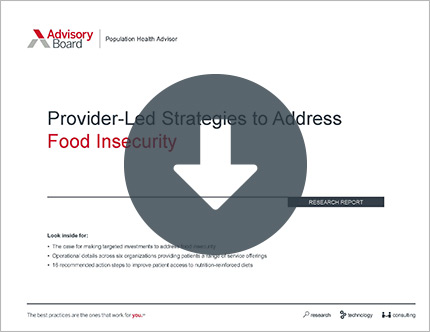Auto logout in seconds.
Continue LogoutProviding Medicare and Medicaid beneficiaries with so-called "healthy food prescriptions" might lower the risk of chronic illnesses and lead to billions of dollars in savings, according to a study recently published in the journal PLOS.
Upcoming webconference series: Population Health 101
Methodology
As Medicare and Medicaid spending continues to grow, researchers and health experts are searching for novel approaches to cutting costs.
With this in mind, researchers from Tufts University's Friedman School of Nutrition Science and Policy explored the effectiveness of programs that provide Medicare and Medicaid beneficiaries with a financial incentive to purchase healthier food items.
The researchers created simulations of two different diet-related initiatives:
- The "F&V incentive," which included both fruits and vegetables; and
- The "healthy food incentive," which included a broader range of healthy foods, including whole grains, nuts, and seafood, in addition to fruits and vegatables.
Under both simulations, Medicare and Medicaid would subsidize 30% of the total cost of the targeted foods for each beneficiary. Specifically, for every dollar spent on one of the initiatives' food items, the government would pay $0.30.
To test the effectiveness of the models, the researchers simulated a nationally representative population of one million Medicare and Medicaid beneficiaries between the ages of 35 and 80using data from three National Health and Nutrition Examination Surveys between 2009 and 2014.
Healthy food prescriptions could reduce risk of illness and cut costs
The study found that both initiatives would lower the risk of chronic illnesses and result in health savings, with the broader healthy food initiative having the biggest effect.
The researchers estimated the F&V incentive model would prevent 1.93 million cardiovascular disease events among Medicaid and Medicare beneficiaries, while the broader healthy food initiative would prevent 3.28 million cardiovascular events.
Both initiatives also appeared to be "highly cost effective," indicating "the same cost-effectiveness as drug treatments for high cholesterol or high blood pressure," according to Yujin Lee, a postdoctoral fellow at the Friedman School.
The researchers estimated F&V incentive would result in $39.7 billion in health care savings at an incremental cost of $18,184 per quality-adjusted life-year (QALY) gained, while the healthy food initiative would save $100.2 billion in health care costs at a cost of $13,194 per QALY. According to Healthcare Finance, medical interventions typically are considered "highly cost effective" if they cost less than $50,000 per QALY gained.
The authors said they saw more significant health benefits in the Medicare population, partly because Medicare is larger in size than Medicaid and because Medicare beneficiaries are older on average.
Experts hope findings will lead to more research trials, interventions
Dariush Mozaffarian, the dean of the Friedman School and a lead author of the study, said, "These new findings support the concept of Food is Medicine: That innovative programs to encourage and reimburse healthy eating can and should be integrated into the healthcare system."
Mylynda Massart, director of the Primary Care Precision Medicine Clinic at the University of Pittsburgh Medical Center who was not involved in the study, called the findings "exciting" but noted that the findings should be replicated in a clinical trial. She added that she hopes the findings "convince people to put money into research studies on actual people in real communities" (Carroll, Reuters, 3/10; Lagasse, Healthcare Finance News, 3/25; Truong, MedCity News, 3/25; Lee et al., PLOS One, 3/19).
Join our popular webconference series: Population Health 101
Back by popular demand: This webconference series includes four online sessions which will cover the fundamental aspects of population health, updated to review the latest trends in the industry.
Don't miss out on the latest Advisory Board insights
Create your free account to access 1 resource, including the latest research and webinars.
Want access without creating an account?
You have 1 free members-only resource remaining this month.
1 free members-only resources remaining
1 free members-only resources remaining
You've reached your limit of free insights
Become a member to access all of Advisory Board's resources, events, and experts
Never miss out on the latest innovative health care content tailored to you.
Benefits include:
You've reached your limit of free insights
Become a member to access all of Advisory Board's resources, events, and experts
Never miss out on the latest innovative health care content tailored to you.
Benefits include:
This content is available through your Curated Research partnership with Advisory Board. Click on ‘view this resource’ to read the full piece
Email ask@advisory.com to learn more
Click on ‘Become a Member’ to learn about the benefits of a Full-Access partnership with Advisory Board
Never miss out on the latest innovative health care content tailored to you.
Benefits Include:
This is for members only. Learn more.
Click on ‘Become a Member’ to learn about the benefits of a Full-Access partnership with Advisory Board
Never miss out on the latest innovative health care content tailored to you.

